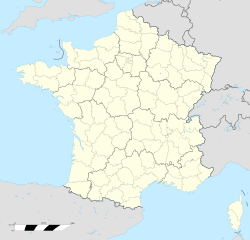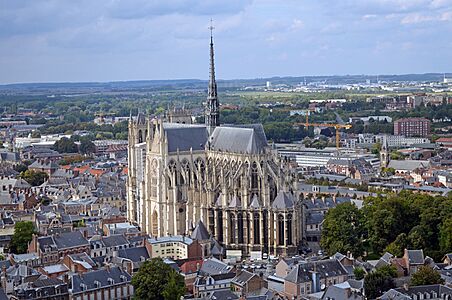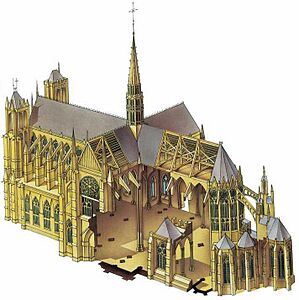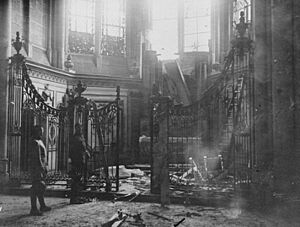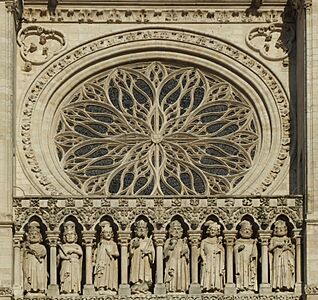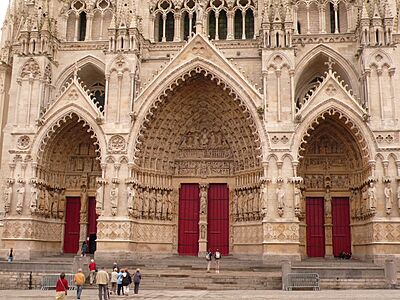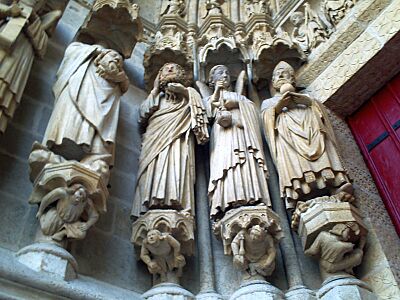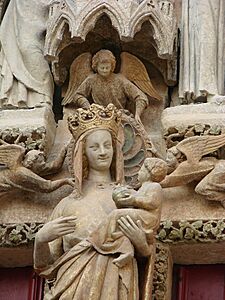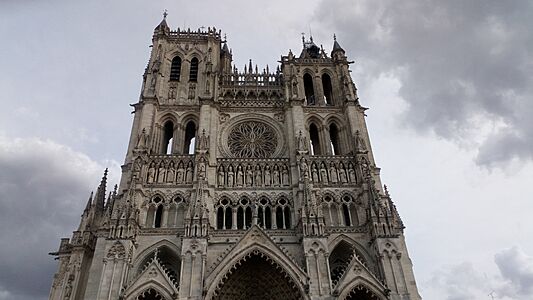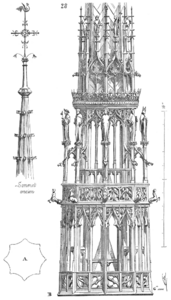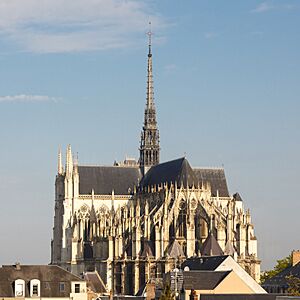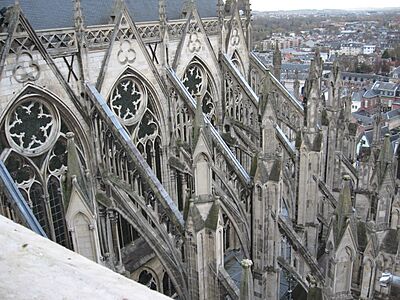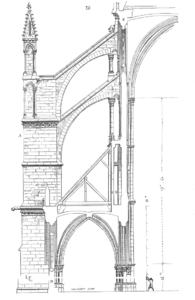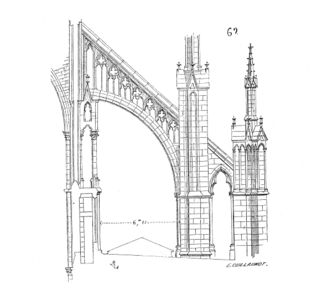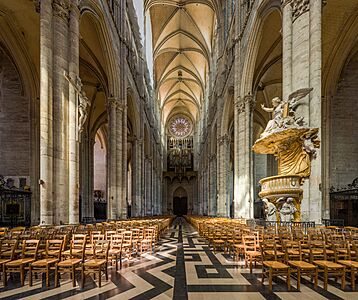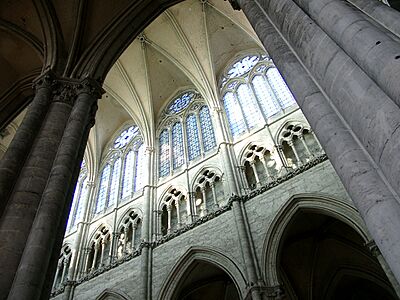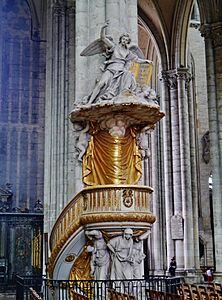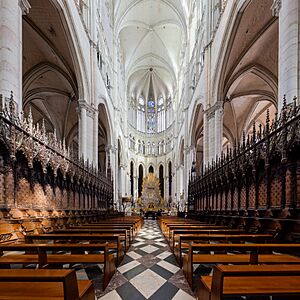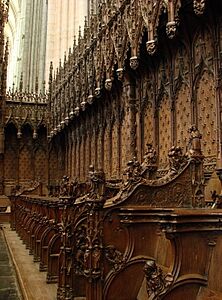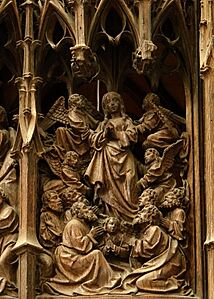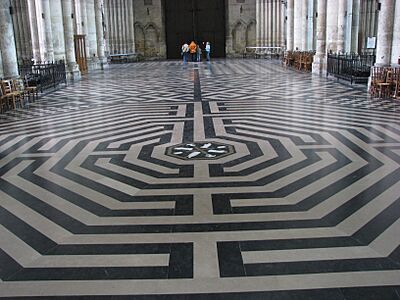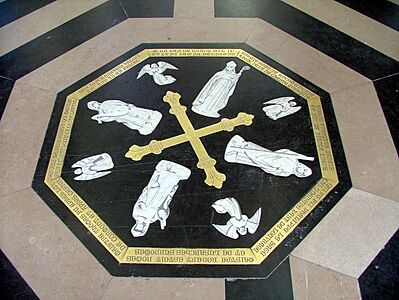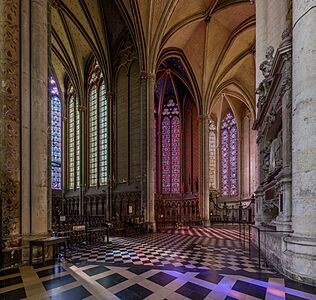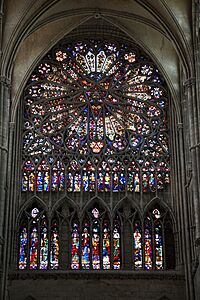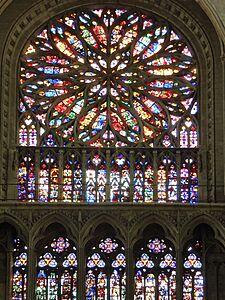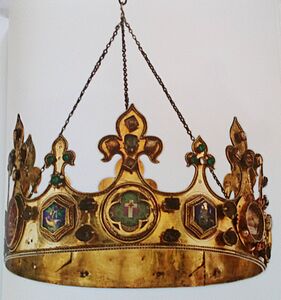Amiens Cathedral facts for kids
Quick facts for kids Amiens Cathedral |
|
|---|---|
| Cathedral of Our Lady of Amiens | |
|
French: Notre-Dame d'Amiens
|
|

Amiens Cathedral
|
|
| 49°53′42″N 2°18′08″E / 49.89500°N 2.30222°E | |
| Location | Amiens |
| Country | France |
| Denomination | Catholic Church |
| History | |
| Status | Cathedral |
| Relics held | Alleged head of John the Baptist |
| Architecture | |
| Functional status | Active |
| Architect(s) | Robert of Luzarches Thomas and Regnault de Cormont |
| Style | Rayonnant |
| Years built | c. 1220–1270 |
| Specifications | |
| Length | 145 m (476 ft) |
| Width | 70 m (230 ft) |
| Nave width | 14.60 m (47.9 ft) |
| Height | 42.30 m (138.8 ft) |
| Other dimensions | Façade: NW |
| Floor area | 7,700 square meters |
| Number of spires | 1 |
| Spire height | 112.70 m (369.8 ft) |
| Administration | |
| Diocese | Amiens |
| Province | Reims |
The Cathedral of Our Lady of Amiens (French: Cathédrale Notre-Dame d'Amiens), often called Amiens Cathedral, is a famous Catholic cathedral in Amiens, France. It is located about 120 kilometres (75 miles) north of Paris. The cathedral is the official church for the Bishop of Amiens.
Amazingly, most of the cathedral was built between 1220 and 1270. This was very fast for a huge Gothic church, which gives it a very unified and consistent style. It is a great example of the High Gothic style. It also features the Rayonnant style, which used tall, thin columns and large windows to let in as much light as possible.
The builders wanted to make the inside of the cathedral feel huge and heavenly. Because of this, Amiens Cathedral is the largest in France by its interior volume. It is so big that it could hold two cathedrals the size of Notre Dame of Paris inside!
Since 1981, the cathedral has been a UNESCO World Heritage Site. It is famous for its beautiful 13th-century Gothic sculptures on the outside and many colorful sculptures inside.
Contents
History of the Cathedral
Early Churches and a Famous Relic
The city of Amiens has a long Christian history. Before the current cathedral, other churches stood on this spot. A fire in 1218 destroyed the previous Romanesque-style cathedral. This fire cleared the way for a new, even grander building.
In 1206, the church received a very important relic: the supposed head of John the Baptist. This relic was brought from Constantinople (modern-day Istanbul). It made Amiens a major destination for pilgrims, which helped raise money for the new cathedral.
Building a Gothic Masterpiece
After the fire of 1218, Bishop Evrard de Fouilloy laid the first stone for the new cathedral in 1220. The main architect, Robert de Luzarches, had a revolutionary idea. He used standardized stone pieces, which made construction much faster.
The architects who followed, Thomas de Cormont and his son Renaud, continued this work. They gave the cathedral its incredible height and feeling of harmony. The main section, called the nave, was finished by 1236. By 1269, the high windows of the choir (the area around the altar) were in place.
Keeping the Cathedral Standing
The original design had a problem. The flying buttresses—stone supports on the outside—were too high. They didn't properly support the weight of the arched ceiling. This put too much pressure on the stone columns.
The building was saved when masons added a second, stronger row of flying buttresses lower down. Later, in 1498, an expert named Pierre Tarisel noticed that some pillars were cracking. He installed a wrought iron chain around the columns. The chain was heated until it was red hot. As it cooled, it tightened and pulled the columns together, making the structure stable. The chain is still there today.
Changes Through the Centuries
In the 16th century, a new rose window was added in the popular Flamboyant Gothic style, known for its flame-like patterns. In the 18th century, the church was updated to follow new rules. The medieval screen that separated the public from the altar was replaced with an iron grill. This allowed everyone to see the service.
During the French Revolution in the late 1700s, the cathedral was damaged. Many statues were smashed, and treasures were stolen. The building was returned to the church in 1800, and repairs began. In the 19th century, the famous architect Eugène Viollet-le-Duc led a major restoration. He tried to bring the cathedral back to its medieval glory, even adding new gargoyles.
Protection in Modern Times
The cathedral's precious stained glass windows were removed for safety during World War I and World War II. The building itself suffered only minor damage. Sadly, some of the stored windows were destroyed in a workshop fire in 1920.
The cathedral's spire was fully restored between 1973 and 1980. In 2001, a major cleaning of the west facade was completed.
The Cathedral's Exterior
The Impressive West Facade
The front of the cathedral, known as the west facade, is famous for its sculptures. It has three large doorways, or portals.
- The central portal shows the Last Judgment, with a statue of Christ deciding who goes to heaven and who goes to hell.
- The left portal is dedicated to Saint Firmin, the first bishop of Amiens.
- The right portal is dedicated to the Virgin Mary.
Above the doorways is the Gallery of Kings, with 22 statues of French kings. Above that is the large rose window. A recent cleaning of the facade revealed that the statues were once brightly painted.
Towers and Spire
The two bell towers on the west facade were finished much later and are not the same height. The south tower was completed around 1366, while the taller north tower was finished in 1406 in the fancy Flamboyant style.
The cathedral's spire, called a flèche in French, rises high above the center of the building. The original spire was hit by lightning in 1528. A new one made of wood covered in lead was built in 1533. It stands 112.70 m (369.8 ft) tall.
-
The flèche as drawn by Viollet-le-Duc
Flying Buttresses
Flying buttresses are the stone arches that support the high walls from the outside. They look like they are "flying" from the lower roof to the upper walls. This clever design allowed builders to make the walls tall and thin, with huge windows that let in lots of light. Without them, the high walls would collapse.
-
Drawing of the nave's buttresses by Viollet-Le-Duc
Inside the Cathedral
The nave is the long central part of the church where the public sits. Its ceiling is 42 meters (138 feet) high, making you feel very small when you stand inside. The walls are built in three levels: huge arches at the bottom, a narrow gallery called a triforium in the middle, and tall windows called a clerestory at the top.
On the north side of the nave is a beautiful Baroque-style pulpit from 1773. It is made of painted and gilded wood and is held up by statues representing Faith, Hope, and Charity.
The Choir and Stalls
The choir is the area at the front of the church reserved for the clergy. One of the greatest treasures of the cathedral is the set of choir stalls, or seats, from the early 16th century.
These wooden stalls are covered in more than 4,000 carved figures. The carvings show scenes from the Bible, mythical animals, and even people from the town doing their jobs. They are incredibly detailed and show the amazing skill of the woodcarvers.
The Labyrinth
On the floor of the nave is a black and white stone path in the shape of a labyrinth. It was laid in 1288. In the Middle Ages, pilgrims would follow the path on their knees as a symbolic journey to salvation. The path is 240 meters long. The one you see today is an exact copy made in the 19th century.
Art and Treasures
Stained Glass Windows
Sadly, much of the original stained glass is gone. Some was lost to storms, accidents, and wars. However, some beautiful early glass from the 13th century remains, especially in the chapels at the east end of the cathedral.
The three large rose windows are from different periods:
- The west rose window (c. 1221-1230) is the oldest and shows Christ in the Apocalypse.
- The north rose window (14th century) is in the radiating Rayonnant style.
- The south rose window (c. 1490) is in the curvy Flamboyant style.
-
High Gothic rose window of the west facade (1221–1230)
The Treasury
The cathedral's treasury holds many precious objects. The most famous item was the supposed head of John the Baptist. The original container, or reliquary, was lost during the French Revolution. A 19th-century copy is now on display.
Another important item is the Crown of Paraclet, a golden crown from the 1230s decorated with jewels. It is said to contain relics from the Passion of Christ.
-
Virgin and Child, polychrome wood (15th c.)
-
Copy of the reliquary for the head of Saint John the Baptist (19th century)
The Cathedral in Color
In the 1990s, during a laser cleaning of the facade, experts discovered that the sculptures were originally painted in bright colors. Today, a special light show called Son et lumière (Sound and Light) is projected onto the cathedral on summer nights and during the Christmas season.
The light show precisely projects the original colors onto the sculptures. This allows visitors to see the cathedral as it would have looked in the 13th century, full of vibrant color.
See also
 In Spanish: Catedral de Amiens para niños
In Spanish: Catedral de Amiens para niños


